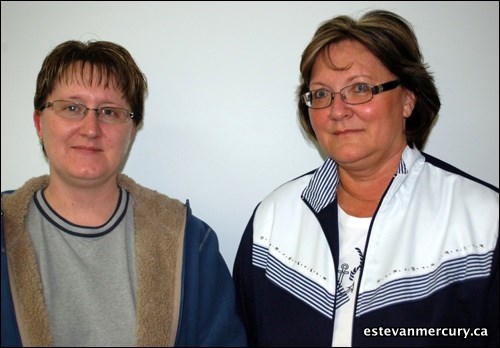The statistical evidence that supports the need to twin Highway 39 and Highway 6 south between North Portal and Regina keeps building according to local members of the Time to Twin committee.
Fifty-two fatalities in 10 years on this stretch of road makes a pretty compelling argument, said local Time to Twin chairwoman Marge Young who was joined by committee member Abbie Mahnke, for a visit with The Mercury on Monday. Mahnke who lives in Hitchcock, commutes between that community and Estevan on a daily basis with a couple of young children as passengers.
"Have I had some close calls? Yes, more than a few very close calls and others I would describe as just close enough, you know, situations I just didn't like," said Mahnke who has been a committee member for over 18 months now. "I've had experiences with highways that have passing lanes, and I don't like them because you still have to deal with aggressive drivers and those who won't pull over or who try to re-enter at the wrong time," she said.
Young said she and committee members had attended a recent North American Trade Corridor meeting in Weyburn to learn more about what is being promoted on that file, and she said they discovered that cross-border traffic is expected to continue to increase over the next few years, especially if the trade corridor concept is embraced and the global transportation hub in Regina expands.
"We sent another e-mail letter to Highways and Infrastructure Minister Jim Reiter pointing out Transport Canada's statistics suggest that twinning a highway increases the safety factor by 60 per cent, not the 35 per cent he's been talking about," said Young.
So far the provincial government representatives have only been suggesting passing lanes as a possible solution for higher traffic volumes along this particular stretch of highway, while Young and her counterparts in Estevan and Weyburn have been touting the need for a regular four-lane throughway to handle current and future traffic loads, most of those being semi-transports.
Armed with recent Saskatchewan Government Insurance (SGI) statistics regarding accidents on Highway 39 and Highway 6 south, Young said the group felt it was time to once again respond to recent statements and letters that Reiter and Highways officials have been issuing.
"SGI's response was quick. Their numbers show that head-on collisions on this stretch have numbered 38 with 61 injuries and 18 fatalities. In other words, your chances of survival in a head-on collision on Highway 39 is about 50-50," said Young.
In that same 10-year frame, there have been 1,040 rollover accidents with 32 of those resulting in fatalities while another 372 were left with injuries.
Other types of accidents on this highway have numbered 286, with two of them ending up with fatalities and 142 injuries.
In total, that makes 52 fatalities in 10 years and that's not acceptable, Young said.
She added that the startling facts behind the head-on statistics might have been more dramatic if the accident reporters had been able to determine "how many of those drivers who were injured or died in rollovers did so because they had to make a quick decision to hit the ditch or take other evasive action to avoid a head-on collision."
With more and more people commuting daily between Weyburn and Regina, Estevan and Regina and Weyburn and Estevan as well as from points in between, Mahnke said the danger levels will continue to rise with more tired drivers on the highways at the beginning and end of each working day.
"We're hoping that Mr. Reiter is sharing the information we gave him with Premier Wall and other MLAs, that's why we've sent a letter to Mr. Wall too," said Young.
The current condition of the existing two-lane highway is deteriorating rapidly, the two women said, so the time to make a decision on its future is advancing quickly.
"It's in its poorest condition between Macoun, Hitchcock and Estevan," said Mahnke, "especially with the ruts and narrow shoulders."
Young said she expected that Highways and Infrastructure would be doing updated traffic counts, just as they are at the Canadian border crossings at North Portal and Estevan Highway, which are showing a steady increase in commercial transport volume every month.
"One good thing about this highway, it isn't filled with curves or poor lines of visibility. If it didn't have good sight lines, I'd hate to think what those fatality statistics would be," said Young.
She said ambulance and truck operators have informed her that the better visibility lines have probably saved a few lives over the past few years as potential head-on collisions became just near-misses.
Young said she and the committee are sticking to their argument that for safety and economic reasons, the highway needs to be twinned, and with emergency vehicle operators, truckers, border officials and policing agencies all recognizing that fact, so should Highways and Infrastructure personnel.
The two women said it was great news to hear that the long-awaited truck bypass around Estevan is going to happen within the next year or two, but that still wasn't going to ease the traffic volume on the main thoroughfares ... those being Highway 39 and 47 in the south and Highway 6 south of Regina.




